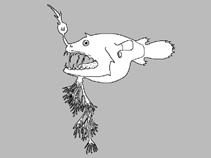http://www.fishbase.org/Summary/speciesSummary.php?genusname=Linophryne&speciesname=sexfilis ---> http://52.67.158.155/Summary/speciesSummary.php?genusname=Linophryne&speciesname=sexfilis
http://52.67.158.155/Summary/speciesSummary.php?genusname=Linophryne&speciesname=sexfilis ---> https://fishbase.net.br/Summary/speciesSummary.php?genusname=Linophryne&speciesname=sexfilis
https://fishbase.net.br/Summary/speciesSummary.php?genusname=Linophryne&speciesname=sexfilis ---> https://fishbase.net.br/summary/Linophryne-sexfilis.html
Linophryne sexfilis

You can
sponsor
this page
Common name (e.g. trout)
Genus + Species (e.g. Gadus morhua)
-

-
About this page
-
Languages
-
User feedbacks
-
Citation
-
Uploads
-
Related species
-


 Add your observation in
Fish Watcher
Upload your
photos
and
videos
Add your observation in
Fish Watcher
Upload your
photos
and
videos
Google image
 No image available for this species;
No image available for this species;
drawing shows typical species in Linophrynidae.
Classification / Names
Common names
|
Synonyms
| Catalog of Fishes(
genus
,
species
) |
ITIS
|
CoL
|
WoRMS
|
Cloffa
Teleostei (teleosts) >
Lophiiformes
(Anglerfishes) >
Linophrynidae
(Leftvents)
Etymology:
Linophryne:
Greek, 'linon' = flax or anything made of flax such as "cord," "rope," or a "net" + Greek, 'phryne' = "toad" (refers to a toadlike fish that fishes with a net) (Ref.
86949
)
.
Environment: milieu / climate zone / depth range / distribution range
Ecology
Marine; bathypelagic; non-migratory; depth range 100 - 1250 m (Ref.
58018
). Deep-water
Eastern Central Atlantic: off Madeira and Canary Is.
Size / Weight / Age
Maturity: L
m
?
range ? - ? cm
Max length : 3.8 cm NG (female)
Short description
Morphology
|
Morphometrics
Dorsal
soft rays
(total): 3;
Anal
soft rays
: 3. Metamorphosed females distinguished by the following characteristics: escal bulb with cylindrical distal prolongation, divided distally into 6 simple tapering filaments; tiny posterior appendage, papilliform; absence of additional escal appendages; simple barbel, undivided, bearing a distal tassel of appendages consisting of simple, cylindrical, distally unpigmented and slightly expanded prolongation of primary stem of barbel, surrounded at base by 3 shorter, unpigmented, compressed pointed branches, each bearing a series of sessile photophores along outer margin (Ref.
86949
).
Only 1 female known. Males unknown (Ref.
13578
).
Life cycle and mating behavior
Maturity
|
Reproduction
|
Spawning
|
Eggs
|
Fecundity
|
Larvae
Bertelsen, E.
, 1986. Linophrynidae. p. 1408-1414. In P.J.P. Whitehead, M.-L. Bauchot, J.C. Hureau, J. Nielsen, and E. Tortonese (eds.) Fishes of the North-eastern Atlantic and the Mediterranean. UNESCO, Paris, Vol. 3. (Ref.
13578
)
IUCN Red List Status (Ref.
130435
)
Data deficient (DD)
; Date assessed:
15 July 2014
CITES
Not Evaluated
Not Evaluated
Threat to humans
Harmless
Human uses
Fisheries: of no interest
FAO - Publication:
search
|
FishSource
|
More information
Countries
FAO areas
Ecosystems
Occurrences
Introductions
Stocks
Ecology
Diet
Food items
Food consumption
Ration
Common names
Synonyms
Metabolism
Predators
Ecotoxicology
Reproduction
Maturity
Spawning
Spawning aggregation
Fecundity
Eggs
Egg development
Age/Size
Growth
Length-weight
Length-length
Length-frequencies
Morphometrics
Morphology
Larvae
Larval dynamics
Recruitment
Abundance
BRUVS
References
Aquaculture
Aquaculture profile
Strains
Genetics
Electrophoreses
Heritability
Diseases
Processing
Nutrients
Mass conversion
Collaborators
Pictures
Stamps, Coins Misc.
Sounds
Ciguatera
Speed
Swim. type
Gill area
Otoliths
Brains
Vision
Tools
|